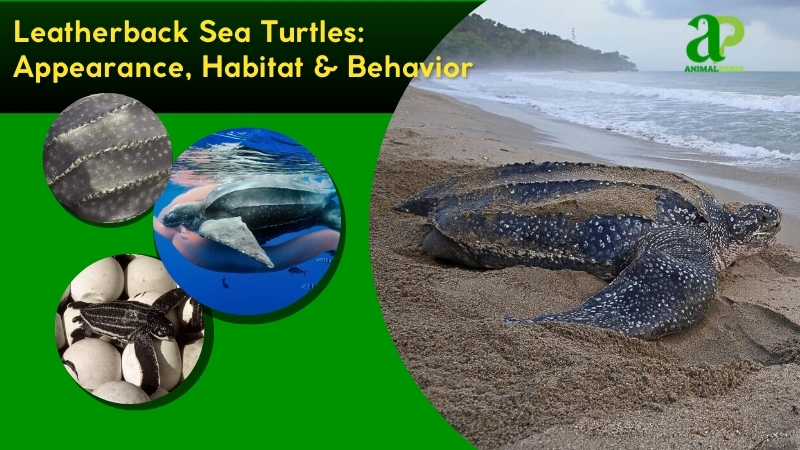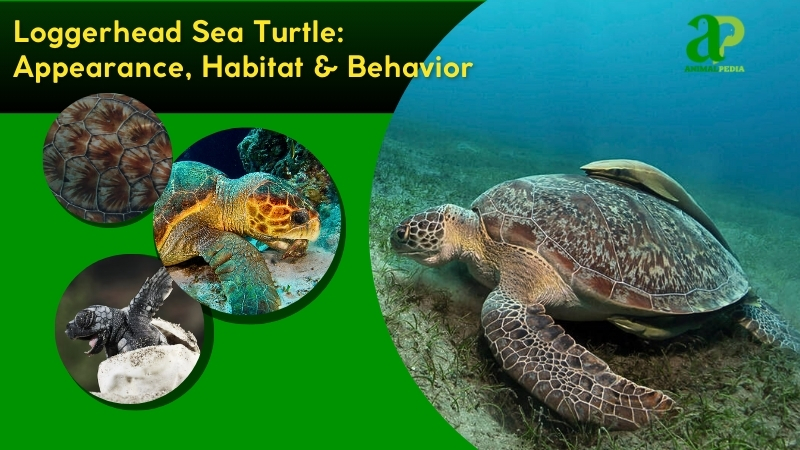The alligator snapping turtle (Macrochelys temminckii) ranks among the world’s largest freshwater turtles and functions as a dominant aquatic predator. Three distinct species comprise the Macrochelys genus: M. temminckii, M. suwanniensis (Suwannee alligator snapping turtle), and M. apalachicolae (Apalachicola alligator snapping turtle)—each distinguished through genetic markers and geographic distribution. These prehistoric-looking reptiles feature massive heads, ridged shells, and powerful jaws. Adult males typically weigh over 176 pounds (80 kg), with exceptional specimens reaching 249 pounds (113 kg).
Native to the watersheds of the southeastern United States, these turtles inhabit slow-flowing rivers, oxbow lakes, cypress swamps, and bayous. The core population thrives throughout the Mississippi River drainage system, while the Suwannee and Apalachicola species are endemic to their namesake river ecosystems in Florida and Georgia.
As apex ambush predators, they employ a hunting strategy. Their worm-like tongue lure attracts unsuspecting prey while they are motionless on murky riverbeds. Their diet encompasses fish, amphibians, aquatic invertebrates, and carrion. Larger specimens occasionally consume small mammals, waterfowl, and other turtles.
Reproduction occurs from spring through early summer. Females excavate nests in sandy riverbanks and deposit 10-50 eggs. Incubation spans 100-140 days, with temperature-dependent sex determination influencing hatchling gender ratios. Newborns receive no parental care and face high predation risks. Sexual maturity occurs between 11 and 13 years, and wild specimens often live beyond 70 years.
This ancient chelonian represents both an evolutionary relic and a keystone species within freshwater ecosystems. Their unique adaptations—from ambush-hunting techniques to longevity—highlight their ecological significance as one of North America’s most specialized aquatic predators, now facing conservation challenges across their historical range.

What do the Alligator Snapping Turtles look like?
The alligator snapping turtle has a robust, tank-like body with a dark brown to black carapace, often mottled with algae for camouflage. Its rugged shell features three prominent keeled ridges, which feel rough and bony, unlike the smoother turtle shell. The skin is thick, warty, and grayish-brown, blending perfectly into swampy habitats. The massive head houses small, dark eyes and supports a sharp, hooked beak.
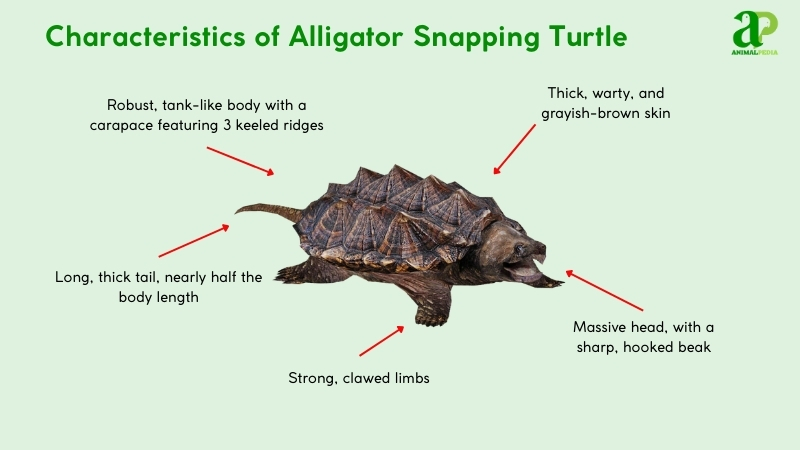
A unique worm-like tongue lures prey—a distinctive feature of this species. The short neck folds under the shell, while the stocky body connects to strong, clawed limbs for digging and gripping. The long, thick tail, nearly half the body length, aids balance. Adults measure 1.5–2.6 feet (0.46–0.8 meters) and weigh 70–200 pounds (32–91 kilograms).
Compared to the common snapping turtle (Chelydra serpentina), alligator snappers are larger, with pronounced shell ridges and a lure-like tongue absent in others. Their beak is sharper than the softer-shelled Florida softshell (Apalone ferox), and their tail is longer. These distinguishing characteristics, confirmed by a 2019 study, set them apart in murky freshwater ecosystems.
How big do Alligator Snapping Turtles get?
Alligator snapping turtles average 1.5–2.6 feet (0.46–0.8 meters) in carapace length and weigh 70–200 pounds (32–91 kilograms). These measurements reflect mature adults in their freshwater habitats.
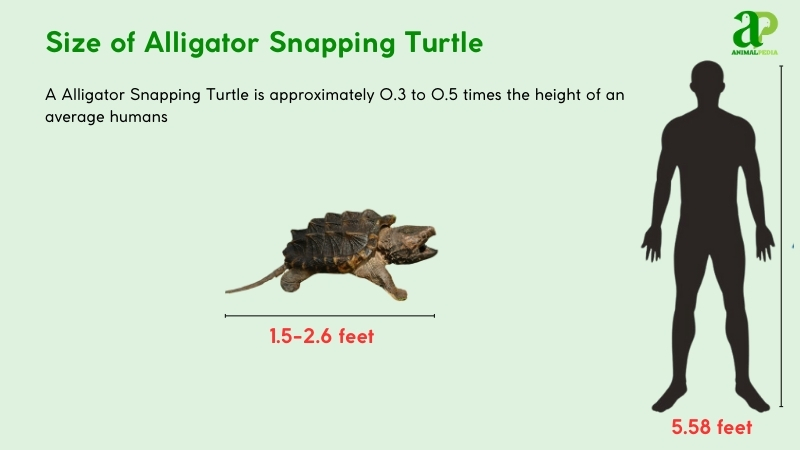
The largest recorded specimen, found in Kansas in 1937, measured 3.3 feet (1 meter) and weighed 403 pounds (183 kilograms), per a 2019 study.
Adults typically reach 2–3.5 feet (0.6–1.1 meters) from snout to tail. Males are generally larger, averaging 2.3 feet (0.7 meters) and 150 pounds (68 kilograms), while females average 2 feet (0.6 meters) and 110 pounds (50 kilograms).
| Trait | Male | Female |
| Length | 1.8–2.6 ft (0.55–0.8 m) | 1.5–2.3 ft (0.46–0.7 m) |
| Weight | 100–200 lb (45–91 kg) | 70–150 lb (32–68 kg) |
What are the unique physical characteristics of the Alligator Snapping Turtles?
The alligator snapping turtle has two distinctive physical traits unseen in other turtle species. It possesses a worm-like tongue appendage and a heavily armored shell with prominent ridges. These adaptations perfect its ambush hunting strategy in murky freshwater habitats.
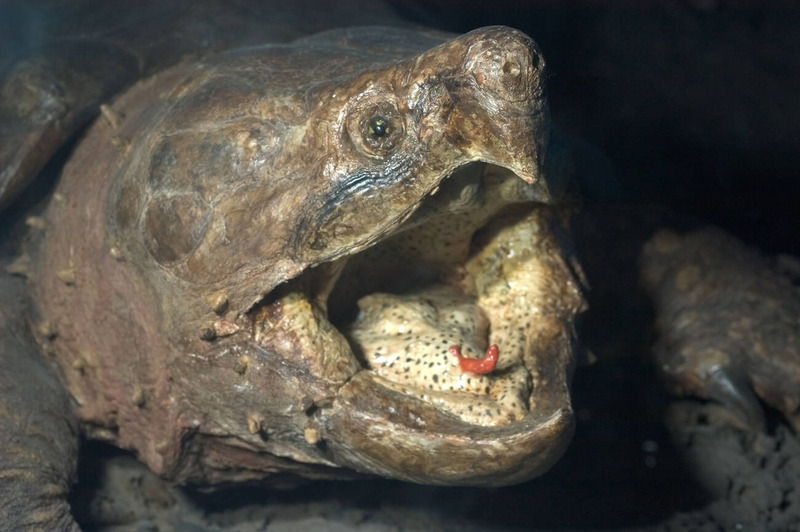
Its specialized lingual lure – a pink, writhing appendage – mimics prey movement to attract fish within striking range of its powerful, hooked beak. Research from 2019 confirms this unique feeding mechanism sets Macrochelys temminckii apart from all other chelonians. The triply-keeled carapace, measuring 18-31 inches (46-80 cm), features three dramatic dorsal ridges that create a jagged profile.
This rough-textured shell typically accumulates algae and sediment, enabling these massive types of reptiles to resemble submerged logs or debris. Unlike their relative, the common snapping turtle (Chelydra serpentina), with its smoother shell, this cryptic morphology provides exceptional camouflage from both potential meals and predators.
The Alligator Snapping Turtle is a fascinating species within the Testudines order, known for its powerful bite and unique appearance. To understand the broader testudines characteristics, including their distinct adaptations and survival strategies, it’s worth exploring the traits that define this group.
How do Alligator Snapping Turtles adapt with their unique features?
The alligator snapping turtle uses two key survival tools in murky freshwater habitats: its worm-like tongue and moss-covered shell with sharp ridges. These features help it blend into its surroundings and attract fish directly into its mouth—a specialized ambush-hunting strategy.
Acute vision lets it detect slight prey movements, while sensitive chemoreceptors identify waterborne scents, enabling precise strikes. Its powerful jaws crush crustaceans, fish, and smaller turtles with ease. The rugged carapace disguises it against riverbed debris, concealing it from both hunters and prey. According to a 2019 behavioral ecology study, these adaptations make Macrochelys temminckii an efficient, stealth-based apex predator in North American waterways.
Anatomy
Alligator snapping turtles exhibit highly specialized anatomical systems that align with their ambush predation strategy and sedentary lifestyle in murky freshwater habitats. These evolutionary adaptations enable them to conserve energy, hide, and capture prey with minimal movement—essential traits for survival in slow-moving rivers and swamps.
- Respiratory System: Lungs enable prolonged submersion, with cloacal respiration supplementing oxygen intake. This allows up to 50-minute dives in low-oxygen waters (Folt & Guyer, 2019).
- Circulatory System: A three-chambered heart pumps blood efficiently, supporting low-energy metabolism. It sustains long periods of inactivity during ambush hunting.
- Digestive System: Powerful jaws crush fish and mollusks, while a large stomach processes tough prey. The worm-like tongue lure enhances the attraction of prey.
- Excretory System: Kidneys filter waste, and cloacal excretion conserves water. This system supports prolonged submersion in freshwater environments.
- Nervous System: Acute vision and chemosensory receptors detect prey in turbid waters. The brain coordinates precise lure movements for effective predation.
Together, these systems form an integrated suite of adaptations refined over millions of years. They make the alligator snapping turtle one of nature’s most efficient ambush predators, perfectly adapted for stealth, endurance, and precision in freshwater ecosystems.
Where do Alligator Snapping Turtles live?
Alligator snapping turtles inhabit freshwater ecosystems throughout the southeastern United States. They concentrate in the Mississippi River basin, the Gulf Coast drainage systems, and major waterways like the Suwannee and Apalachicola rivers.
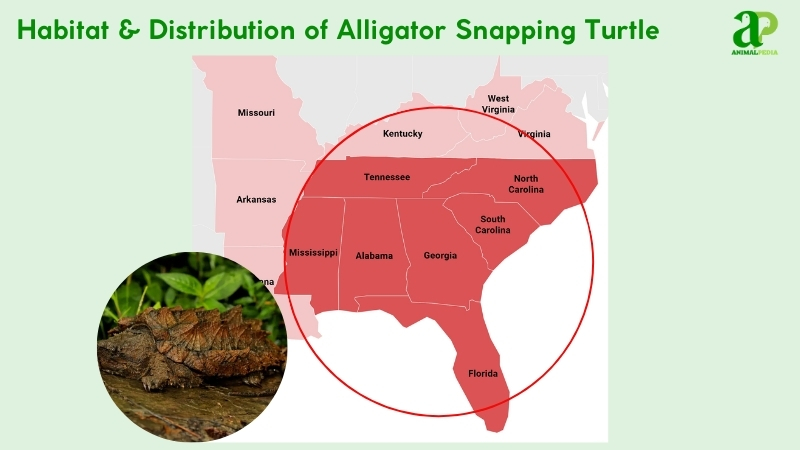
These prehistoric reptiles thrive in the murky waters of rivers, swamps, and oxbow lakes. Such habitats offer submerged logs and dense aquatic vegetation for camouflage and shelter. The slow-moving waters match their sedentary lifestyle and ambush hunting technique.
Macrochelys temminckii (their scientific name) has occupied these ecological niches for millions of years without significant range shifts. They are ear-round residents in deep, sheltered waters, rarely venturing to new territories. A comprehensive 2019 ecological study confirmed their habitat fidelity and specialized aquatic adaptations to these southern watersheds.
How do seasonal changes affect their behavior?
Alligator snapping turtles exhibit distinct seasonal behaviors, shaped by temperature changes and reproductive needs, in freshwater ecosystems.
- Breeding Season (April–June): As waters warm, males become more territorial and seek mates, while females travel to sandy banks to lay eggs. Increased movement during this period supports successful reproduction.
- Foraging Season (July–March): With breeding concluded, turtles shift focus to feeding. They rely on ambush tactics and their tongue lure to catch prey. As temperatures drop, especially in northern areas, activity declines, and some individuals enter brumation to conserve energy.
These seasonal patterns, documented by Folt & Guyer (2019), allow alligator snapping turtles to synchronize energy expenditure with environmental conditions, maximizing survival and reproductive success across changing riverine habitats.
What is the behavior of Alligator Snapping Turtles?
Alligator snapping turtles are solitary and sedentary, displaying behaviors finely tuned for ambush predation in freshwater environments. Their physical and behavioral traits reflect evolutionary adaptations to murky rivers and swamps, where stealth and minimal movement maximize survival and hunting efficiency.
- Feeding Habits: They lure fish with a worm-like tongue, snapping with powerful jaws. Prey includes fish, mollusks, and carrion.
- Bite & Venomous: Non-venomous, their bite delivers 1,000 pounds of force. It deters predators and secures prey.
- Daily Routines and Movements: Mostly nocturnal, they are motionless for hours. Movements are minimal, covering 0.1–0.3 miles (0.16–0.5 km) daily.
- Locomotion: Slow crawlers, they use strong limbs to navigate riverbeds. Swimming is rare, reserved for deeper waters.
- Social Structures: Solitary, they avoid interaction except during mating. Territorial disputes occur among males.
- Communication: Limited to physical displays like jaw gaping. No vocalizations are observed.
To understand their ecological role, exploring their feeding habits reveals how their unique lure drives predatory success.
What do Alligator Snapping Turtles eat?
Alligator snapping turtles are carnivorous, favoring fish, frogs, and mollusks, lured by their worm-like tongue. They rarely attack humans and instead focus on aquatic prey. Their diet shifts slightly with age and season, per a 2019 study. They snap prey with powerful jaws, swallowing whole or tearing it into pieces. Large prey can cause choking, though their bite force (1,000 pounds) handles most items.
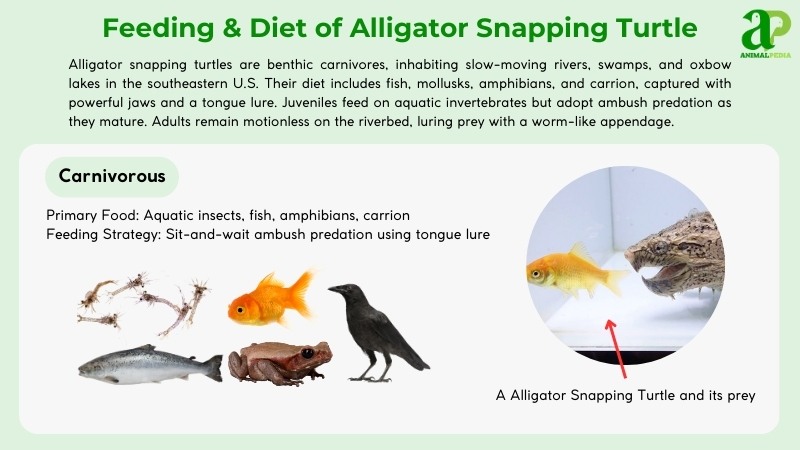
- Diet by Age:
Hatchlings and juveniles primarily feed on aquatic insects, small fish, and tadpoles. As they grow, their diet shifts toward larger prey such as fish, frogs, and mollusks. Adults become opportunistic carnivores, ambushing larger prey and occasionally consuming carrion. A 2020 study notes that dietary diversity increases with age due to improved jaw strength and hunting efficiency.
- Diet by Gender:
Male and female alligator snapping turtles display similar dietary patterns. Both sexes inhabit overlapping habitats and feed on the same prey types. Studies show no significant sex-based variation, suggesting feeding behavior is influenced more by availability and habitat than gender.
- Diet by Seasons:
In warmer months (April–October), feeding activity increases, with turtles exploiting abundant fish and amphibians. During cooler months (November–March), activity slows, and some individuals enter brumation, significantly reducing food intake. Seasonal changes in metabolism and prey availability shape these feeding patterns.
How do Alligator Snapping Turtles hunt their prey?
Alligator Snapping Turtles hunt through patient ambush tactics in freshwater ecosystems. These prehistoric-looking chelonians are motionless on river bottoms, often partially buried in mud or camouflaged among aquatic plants.
Their most hunting adaptation is a vermiform lure—a pink, worm-shaped appendage on their tongue that they wiggle to attract prey. This specialized appendage mimics the movement of small invertebrates, drawing curious fish directly into striking range.
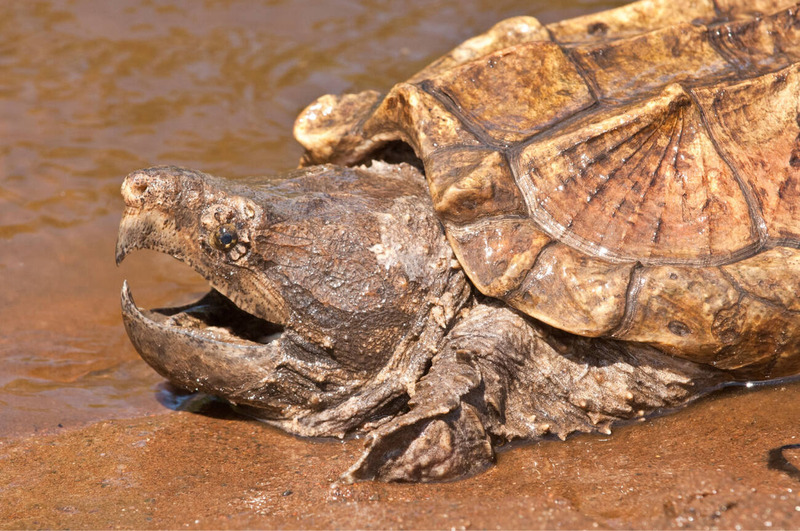
When prey approaches the lure, the turtle’s powerful jaws snap shut with tremendous force—up to 1,000 pounds per square inch. Their sharp, hooked beaks easily sever flesh and crush shells. The strike happens in less than 50 milliseconds, giving victims virtually no chance to escape.
These macrochelys temminckii primarily target fish, but opportunistically consume amphibians, smaller turtles, snakes, crayfish, clams, and carrion. Unlike many aquatic predators, they don’t actively pursue prey; instead, they conserve energy through a sit-and-wait strategy.
Despite their sluggish appearance, their lingual luring technique represents one of nature’s most specialized predatory adaptations among reptiles, allowing them to thrive as apex predators in southeastern U.S. waterways for over 20 million years.
Are Alligator Snapping Turtles venomous?
Alligator Snapping Turtles don’t possess venom. Despite this, these ancient reptiles employ powerful predatory tactics in their freshwater domains. Their most common strategy involves ambush hunting, where they wait until striking with massive jaw strength—up to 1,000 pounds of bite force.
When hunting, these chelonians use a unique lingual lure. Their vermiform (worm-like) tongue appendage wiggles to attract fish. Once prey approaches, the turtle’s lightning-fast strike captures it with precision. Their sharp, hooked beaks function effectively as biological traps, making escape nearly impossible.
The cryptic coloration and sedentary nature of Macrochelys temminckii allow them to be submerged and motionless for up to 50 minutes. This evolutionary adaptation creates perfect camouflage among river bottoms and submerged logs. While lacking toxins, these aquatic apex predators demonstrate nature’s efficiency through specialized anatomy and behavior rather than venom.
When are Alligator Snapping Turtles most active during the day?
Alligator Snapping Turtles are most active during crepuscular hours—early mornings and late afternoons. They exploit these cooler temperature periods for hunting and movement, conserving energy when thermal conditions are optimal.
At dawn, these prehistoric-looking chelonians engage in thermoregulation by basking, raising their body temperature to prepare for foraging activities. As dusk approaches, they resume active hunting, using their specialized lingual lure to attract prey in aquatic environments.
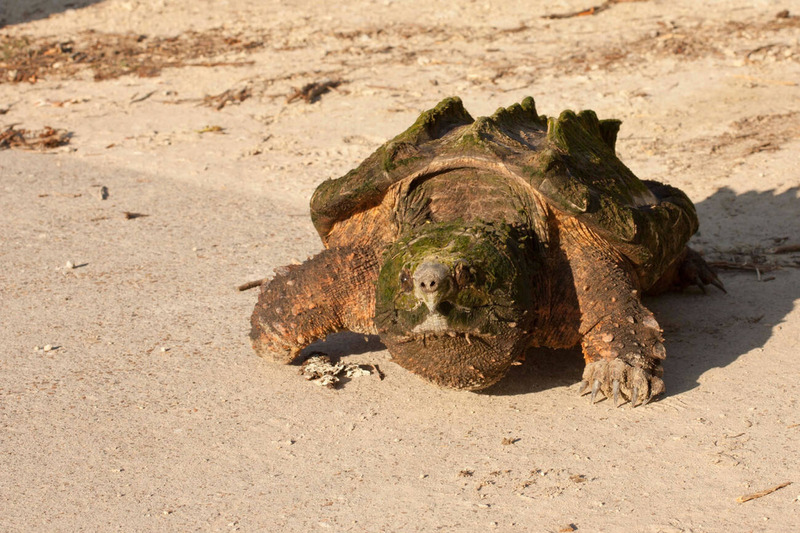
These cryptic reptiles navigate their freshwater habitats —bayous, streams, and floodplain wetlands —with stealth. Their activity patterns follow circadian rhythms aligned with prey availability and reduced predation risk during transition periods.
When observing Macrochelys temminckii during their active periods, maintain an appropriate distance as these apex predators deserve both respect and space in their natural ecosystem. Their behavioral ecology represents a fascinating example of temporal niche specialization in aquatic reptiles.
How do Alligator Snapping Turtles move on land and water?
Alligator Snapping Turtles move distinctly in both terrestrial and aquatic environments. On land, they trudge slowly, using powerful limbs and sharp claws to navigate terrain. Their lumbering gait reflects their primarily aquatic lifestyle.
In water, these prehistoric-looking chelonians transform. They become agile swimmers, propelling themselves through rivers and lakes with their webbed feet. Their hydrodynamic carapace reduces drag, enabling efficient movement during both hunting and evasion.
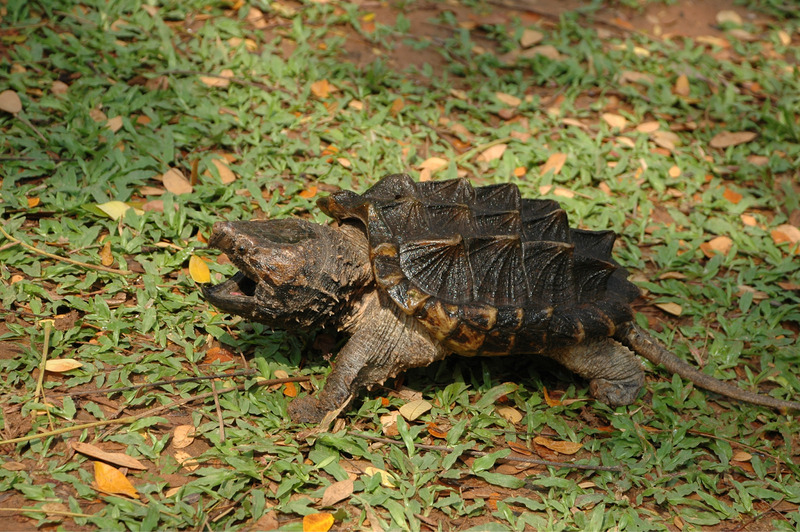
The Macrochelys temminckii demonstrates locomotion adaptability. In muddy substrates, they use alternating leg movements similar to other freshwater turtles. Their mobility strategy shifts between slow, deliberate terrestrial crawling and more fluid aquatic propulsion.
These apex predators rarely venture far from water. When they do travel overland, typically during nesting season, their movements are deliberate and energy-conserving. Their aquatic proficiency contrasts sharply with their awkward terrestrial mobility—a testament to their specialized evolution as ambush predators in freshwater ecosystems.
Do Alligator Snapping Turtles live alone or in groups?
Alligator Snapping Turtles typically prefer to live alone, leading solitary lives in their habitats. They’re solitary creatures that roam independently through waters and riverbeds. Unlike some animals that thrive in groups, these turtles are content with their own company, much like the lone wolves of the aquatic world.

Their independence allows them to confidently explore and survive without the need for companionship. These turtles are experts at embracing their solitary nature, using their size and demeanor to navigate and conquer the waters on their own.
This independence enables them to focus on hunting and survival without the distractions of group interactions.
How do Alligator Snapping Turtles communicate with each other?
How do Alligator Snapping Turtles reproduce?
Alligator snapping turtles reproduce through oviparity, depositing eggs in land-based nests. The breeding season spans April to June, when males actively seek females in warmer waters. Males initiate courtship through physical contact—nudging and neck-biting—leading to brief copulation in shallow riverbed environments.
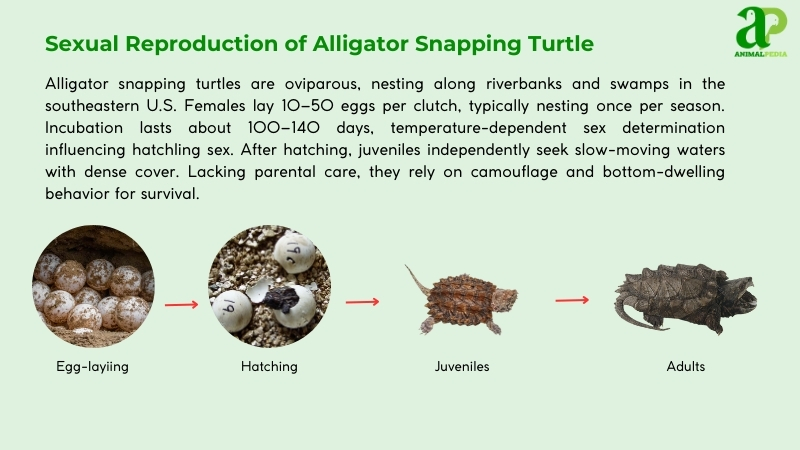
Female turtles excavate nests 20–30 inches deep in sandy substrates near riverbanks, where they deposit clutches of 10–50 eggs. Each egg weighs approximately 1.2 ounces (34 grams), as documented in comprehensive 2019 research. After egg-laying, females carefully conceal their nests to reduce predation risk. Males return to solitary hunting patterns while females may produce additional clutches. Environmental threats, such as flooding and human interference, disrupt nesting success, reducing hatchling survival rates by 30% across the Mississippi watershed.
The incubation period lasts 100–140 days, and hatchlings emerge at 2–3 inches (5–7.6 centimeters) long. Juvenile turtles initially consume invertebrates and grow slowly, taking 11–13 years to reach sexual maturity. These chelonians typically live 20–70 years, with females producing 100–200 eggs during their reproductive lifespan.
Habitat degradation poses significant challenges to reproductive cycles, though conservation initiatives focused on nest protection have improved population stability in key river ecosystems. These preservation efforts are critical for the species’ long-term viability.
How long do Alligator Snapping Turtles live?
Alligator snapping turtles live long lives. In the wild, they often live to be over 70 years old. Some captive specimens have survived beyond 100 years, though these cases are exceptional. Their longevity depends on habitat stability, prey abundance, and limited human impact. Wild populations typically live 45-70 years.
Males and females share similar lifespans. Females face slightly higher mortality risks during nesting periods. Their impressive life expectancy stems from slow metabolic rates and delayed sexual maturity. These characteristics typify large, long-lived chelonians (Folt & Guyer, 2019).
What are the threats or predators that Alligator Snapping Turtles face today?
Alligator snapping turtles face significant threats, primarily from human activities, as well as from natural predators targeting eggs and juveniles. These pressures reduce populations in their southeastern U.S. riverine habitats.
- Habitat Loss: River damming and wetland drainage destroy nesting and foraging sites, reducing habitat by 30% in the Mississippi basin (Folt & Guyer, 2019).
- Overharvesting: Illegal trapping for meat and the pet trade depletes populations, with 20% declines in Georgia since 2000.
- Pollution: Chemical runoff impairs water quality, causing 15% higher mortality in polluted rivers.
- Invasive Species: Introduced fish compete for prey, limiting food by 25% in some drainages.
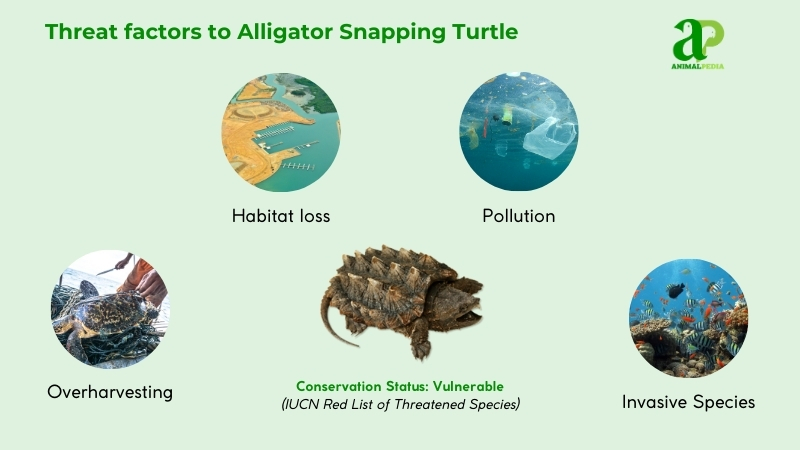
Predators include raccoons, otters, and birds preying on eggs and hatchlings. Adults, with their strong bite, face few natural threats.
Human impacts are profound, with populations dropping 50% in some areas due to overharvesting and habitat alteration, per Folt & Guyer (2019). Dredging disrupts riverbeds, and fishing bycatch kills juveniles. Conservation efforts, like nest protection and harvest bans, aim to curb declines, but enforcement is challenging.
Are Alligator Snapping Turtles endangered?
Alligator snapping turtles are not endangered but face significant threats. The IUCN lists this prehistoric reptile species as “Vulnerable” due to declining populations caused by habitat destruction and overharvesting.
Research indicates only 10,000–20,000 mature specimens across their southeastern U.S. range. Several states, such as Georgia and Louisiana, have documented substantial population declines. Commercial exploitation for meat and the exotic pet trade have reduced populations by 30–50% in certain river ecosystems since the 1980s.
River modification through damming and channelization has destroyed approximately 20% of suitable habitat in the Mississippi River basin, creating isolated populations. Conservation initiatives, including harvest restrictions and nesting site protection, show promise in some areas, though illegal collection continues to threaten recovery efforts. Ongoing population monitoring is essential to prevent this ancient chelonian from sliding toward endangered status.
What conservation efforts are underway?
Alligator snapping turtles face threats from habitat destruction and overharvesting, sparking intensive conservation initiatives. The U.S. Fish and Wildlife Service (USFWS) and Nashville Zoo spearhead efforts to restore populations in southeastern waterways.
Since 1999, USFWS has implemented reintroduction programs, releasing captive-raised juveniles in Oklahoma, Louisiana, and Tennessee. Nashville Zoo’s Headstart and Release program, established in 2016, nurtures hatchlings for 3–4 years before release, boosting survival rates in the wild (Folt & Guyer, 2019).
In 2021, USFWS proposed listing the species as threatened under the Endangered Species Act, implementing a Section 4(d) rule. This prohibits poaching, accidental capture, and habitat modification, with exemptions for authorized breeding programs. Commercial collection is now outlawed across the entire range; recreational harvest is legal only in Louisiana and Mississippi.
Tishomingo National Fish Hatchery’s conservation program has released over 1,200 juvenile turtles into Kansas and Oklahoma rivers since 1999, with 70% surviving for at least 1 year (Dreslik et al., 2017). Natchitoches National Fish Hatchery reports similar results, successfully reintroducing 27 specimens in Texas in 2021.
Conservation victories include thriving populations in Oklahoma’s Caney River, where reintroduced turtles gained more weight than their captive counterparts, demonstrating successful wild adaptation. These protection measures, reinforced by the CITES Appendix II listing, strengthen international trade regulations and safeguard this ancient reptile’s future.
Frequently Asked Questions
How Do Alligator Snapping Turtles Communicate With Each Other?
To communicate, alligator snapping turtles rely on vibrations and chemical signals. They sense vibrations through their shells and release distinct scents. By doing this, they can convey important information to their counterparts, aiding in interaction and survival.
Do Alligator Snapping Turtles Have a Lifespan Similar to Other Turtles?
Alligator snapping turtles have a long lifespan similar to that of other turtle species. They can live for several decades. These hardy creatures thrive in their respective habitats, adapting to environmental conditions for sustained longevity.
Can Alligator Snapping Turtles Be Kept as Pets?
Yes, you can keep alligator snapping turtles as pets, but they require specialized care due to their size and habitat needs. Confirm you have the means to provide a suitable environment before considering them as pets.
What Is the Role of Alligator Snapping Turtles in Their Ecosystem?
In their ecosystem, alligator snapping turtles play an essential role as top predators. They help maintain balance by controlling populations of aquatic animals. Without them, the food chain could be disrupted, affecting the entire habitat.
Are There Any Specific Conservation Efforts Focused on Alligator Snapping Turtles?
Yes, there are specific conservation efforts focused on these turtles. Organizations raise awareness, protect habitats, and work to reduce threats like habitat loss and overharvesting. Your support can make a real difference in saving these species.
Conclusion
Alligator snapping turtles are an iconic species in North American aquatic ecosystems. Their distinctive morphology —from rugose carapaces to powerful jaw mechanisms —positions them uniquely as apex predators within freshwater food webs. These ancient reptiles, scientifically classified as Macrochelys temminckii, employ lingual luring—a specialized hunting technique involving their worm-like tongue appendage—to capture prey efficiently in riverine and lacustrine environments.
These prehistoric-looking chelonians contribute significantly to ecological balance by regulating fish populations and serving as environmental health indicators. Their presence reflects the integrity of wetlands throughout the southeastern United States, particularly in the Mississippi River drainage system. Conservation biologists recognize them as keystone species whose survival correlates with broader habitat preservation efforts.
When encountering these living fossils in their native range, remember their ecological significance and threatened conservation status. Their continued existence depends on habitat protection, reduced collection pressure, and informed public appreciation of their evolutionary significance in North American herpetofauna.






